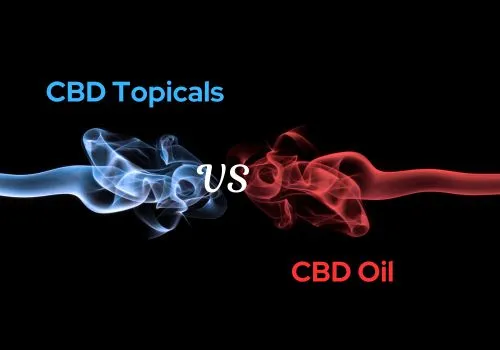As the popularity of cannabidiol, better known as CBD, continues to surge, more and more people are curious about its potential benefits. A frequently asked question is if CBD oil applies topically on the skin to alleviate pain. Let’s explore this in more detail.
Understanding CBD
Before diving into the specifics of topical CBD use, let’s understand what CBD is. CBD is a cannabinoid found in the cannabis plant, and unlike its well-known counterpart THC, it does not possess psychoactive effects that cause a “high.” Instead, CBD is being extensively researched for its potential therapeutic benefits, which include pain management, anxiety reduction, and sleep improvement, among other possible uses.
Can I Rub CBD Oil on My Skin for Pain?
CBD can relieve pain when taken orally, with CBD gummies being a popular option for medicinal use. However, research is emerging into the benefits of topical CBD use on the skin. Preliminary research indicates that CBD could be a successful remedy for specific skin ailments.
It is important to note that much of the current research involves using CBD in combination with THC oil for topical application. The research also suggests that CBD oil may be particularly effective in managing inflammation.

How to Use CBD Oil for Pain the Right Way
While CBD oil can be used to alleviate pain, it is important to choose the appropriate form. Applying CBD oil topically to the skin is not the most effective way to manage physical discomfort.
Below are a few recommendations on how to utilize CBD oil for pain management effectively:
- It’s crucial to consult with a healthcare provider to determine whether CBD oil is a suitable treatment for your particular pain type and severity.
- Choose a high-quality CBD oil from a reputable source.
- Initiate with a small dose and gradually raise it until the desired pain alleviation is achieved. Dosage amounts will vary depending on factors such as body weight, metabolism, and the concentration of CBD in the oil.
- Take the CBD oil sublingually (under the tongue) for quicker and more effective absorption into the bloodstream. Keep the oil under your tongue for at least 60 seconds before swallowing.
- Be consistent with your dosage and usage schedule to achieve optimal pain relief.
- Keep track of your symptoms and modify the dosage as required.
- Stay alert for possible side effects, and discontinue the oil if you encounter any unfavorable reactions.
How to Rub CBD OIL on Your Skin for Pain
Topical application of CBD oil may not be as effective as other methods, such as sublingual (under the tongue) administration. However, it can still provide some relief for localized pain and inflammation. As a standard practice, always seek advice from a healthcare provider before initiating any new treatment plan.
- Choose a high-quality CBD oil designed for topical use. Look for products that are labeled as “CBD oil salve,” “CBD oil balm,” or “CBD oil lotion.”
- Clean the affected area of your skin before application. This will aid in removing any dirt or bacteria that may cause irritation.
- Applying a small quantity of CBD oil to the affected area using gentle circular motions. Be sure to massage the oil thoroughly into the skin to ensure proper absorption.
- Repeat the process as necessary. The frequency of applying CBD oil may vary depending on the severity of your pain, and it may require several applications throughout the day.
- Avoid possible side effects and halt usage if any unfavorable reactions occur.
Can CBD Oil Be Used Topically?
CBD oil can be used topically to address localized pain and inflammation. Topical products infused with CBD, like balms, creams, and lotions, can address specific areas of discomfort by directly applying them to the skin. When applied topically, CBD oil enters the skin and engages with adjacent cannabinoid receptors to deliver targeted relief. However, it’s important to note that topical application may not be as effective as other methods, such as sublingual administration, for overall pain relief. Before applying CBD oil topically, it’s crucial to seek advice from a healthcare provider, as with any new therapy.
CBD Topicals Vs CBD oil

CBD topicals and CBD oil are both products that contain cannabidiol (CBD), a non-intoxicating compound derived from the hemp plant. However, there are some differences between the two.
| Property | CBD Topicals | CBD Oil |
| Usage | Applied directly to skin | Ingested orally or sublingually |
| Absorption | Localized | Systemic |
| Onset of Effects | Rapid | Varies depending on ingestion |
| Duration of Effects | Short-lived | Long-lasting |
| Dosage Control | Easy to control | Can be challenging to measure |
| Convenience | Easy to apply | Requires administration equipment |
| Potential Side Effects | Rare, localized skin irritation | Possible side effects, such as nausea, dizziness or dry mouth |
It’s important to note that CBD topicals and CBD oil have unique properties and uses, and the choice between them will depend on individual needs and preferences. Always seek advice from a healthcare provider before initiating any new treatment plan.
What is the time frame for the Skin to absorb CBD?
The time frame for the Skin to absorb CBD can vary depending on several factors, such as the concentration of CBD in the product, the type of product used, and individual factors, such as skin type and health. However, it generally takes around 30 minutes to an hour for CBD to be absorbed through the skin and reach the bloodstream. The effects of CBD may continue for several hours after absorption. It’s important to note that CBD’s absorption time and effects may vary for different individuals and products, so it’s recommended to consult a healthcare professional for advice on using CBD for your specific needs.
How Much CBD Should You Use?
Determining the appropriate amount of CBD to use depends on several factors, such as individual needs, body weight, metabolism, and the concentration of CBD in the product. To achieve the desired effect, it’s recommended to begin with a low dosage and gradually increase it. A common starting dosage is 5-10mg of CBD, and 5mg increments can increase it until the desired effect is reached. For some individuals, a higher dosage may be needed for optimal results. It’s crucial not to surpass the suggested dosages, as excessive CBD intake can lead to unfavorable outcomes. It’s always advisable to seek guidance from a healthcare provider before initiating any new treatment plan, which also includes using CBD.
CBD and Pain Relief
The endocannabinoid system (ECS) is a complex network within the body responsible for regulating various functions such as appetite, sleep, immune system response, and pain. Researchers suggest that CBD interacts with the essential elements of the ECS, including endocannabinoids, receptors, and enzymes. This interaction may alleviate pain and inflammation by reducing the body’s inflammatory response and desensitizing pain receptors.
Multiple studies have suggested that CBD may have pain-relieving effects. A review from the European Journal of Pain showed substantial evidence supporting the use of cannabis in chronic pain treatment, especially for patients with multiple sclerosis and cancer.
Topical CBD for Pain
CBD can be consumed in many ways, including orally (as tinctures or capsules), inhaled (as vapour), or applied directly to the Skin (as a topical cream or oil). The latter method has gained popularity for treating localized pain and inflammation.
When applied topically, CBD doesn’t reach the bloodstream but instead interacts with cannabinoid receptors (part of the body’s endocannabinoid system) in the Skin. This local, targeted interaction may relieve pain in a specific area.
The Arthritis Foundation notes that while CBD may not cure arthritis, it might help with symptoms such as pain or inflammation. Preliminary research has suggested that CBD may help with arthritic pain, and many people self-report improvements in pain management when using topical CBD.
How to Use CBD Oil Topically
If you’re considering using CBD oil topically for pain, here’s a simple guide:
- Choose a High-Quality CBD Oil: CBD products are not uniformly manufactured. To ensure quality, search for products that have undergone third-party testing, have clear labelling and originate from reputable brands.
- Clean the Area: Before applying CBD oil, clean the skin area with soap and water, then dry it thoroughly.
- Apply the Oil: Dab a small amount of CBD oil onto your fingers and rub it gently onto the Skin. You don’t need to use too much—just enough to cover the area.
- Massage Thoroughly: Rub the oil into your Skin until it is fully absorbed.
- Wait and Observe: Give it some time to work. If you don’t notice any relief after an hour, you may wish to apply a little more.
- Repeat as Necessary: You can apply topical CBD oil multiple times a day, depending on your pain levels and the product’s instructions.
Side Effects of Rubing Cbd oil on Skin
Applying CBD oil topically is typically considered safe and associated with minimal side effects. However, certain individuals may encounter mild skin irritation or allergic reactions, including redness, itching, or rash.
It’s worth mentioning that CBD oil may interact with specific medications, and therefore, it’s crucial to consult with your doctor before using it. This is particularly important if you’re currently taking any prescription medications.
Additionally, it’s important to ensure you are using a high-quality CBD oil product, as some low-quality products may contain harmful additives or contaminants that can cause skin irritation or other adverse effects.
While topical CBD oil is generally considered safe, it’s always a good idea to talk to your doctor before using it, especially if you have any underlying health conditions or concerns.

Benefits of Applying CBD Oils on Skin
Cannabidiol, or CBD, is a naturally occurring compound derived from the cannabis plant. In recent years, it has become increasingly popular due to its potential health benefits, including its topical application on the Skin.
Here are some of the benefits of applying CBD oils on the Skin:
Relieves pain and inflammation
The anti-inflammatory properties of CBD oil can be beneficial in alleviating pain and reducing inflammation in the body. Its topical application can effectively target specific areas of the Skin that are experiencing discomfort or inflammation.
Improves Skin Health
CBD oil is recognized for its antioxidant properties, which can protect the skin from harm caused by free radicals. Furthermore, it includes essential fatty acids that nourish and hydrate the skin, promoting its overall health and youthful appearance.
Reduces Aacne
CBD oil may aid in regulating sebum production, the oil responsible for acne development, and decrease the inflammation linked to acne.
Relieves Skin Conditions
CBD oil is effective in reducing the symptoms of various skin conditions, including psoriasis, eczema, and dermatitis.
Promotes Relaxation
CBD oil’s calming properties promote relaxation and minimize stress. Topical application may help to soothe the Skin and induce a sensation of tranquillity.
In summary, the topical application of CBD oils can offer numerous advantages, including alleviating pain and inflammation, enhancing skin health, and promoting relaxation. Nevertheless, choosing high-quality products and seeking advice from a healthcare professional before using them to ensure their safety and efficacy is crucial.
FAQ
Does rubbing CBD oil on skin help pain?
CBD is frequently incorporated into oils, such as hemp seed oil, by manufacturers for use as a constituent in skin lotions and creams. Studies indicate that CBD possesses anti-inflammatory properties and may provide relief for particular skin conditions. Furthermore, CBD-infused skin cream may aid in the relief of sore joints.
Can you rub CBD oil on a painful area?
For the topical application of CBD oil, you can directly massage it onto the affected joint. However, before doing so, it is essential to perform a patch test to ensure that your skin does not react negatively. Additionally, it is crucial to avoid applying the oil to broken skin.
Does CBD oil work directly on skin?
According to Nima Gharavi, a skin cancer surgeon and dermatologist at the Cedars-Sinai Cosmetic Dermatology Program, CBD potentially has hydrating properties for the skin and anti-inflammatory effects. Thus, employing a CBD-infused product may assist in treating dry skin or particular skin conditions that involve inflammation.
Where should I rub CBD?
Is it possible to apply CBD oil topically for soreness? Yes, topical CBD products are directly applied to the skin to alleviate tension or enhance skin health. It is typical to massage CBD onto sore shoulders, knees, or any area experiencing tightness.
Conclusion
While research is still ongoing, CBD oil may help manage pain when applied topically. It’s essential to remember that CBD may affect individuals differently, and a product that works for one person may not have the same effect on another. Therefore, consulting with a healthcare professional before commencing any new treatment is advisable.
The future of CBD as a pain management tool is promising and as we continue to understand more.

